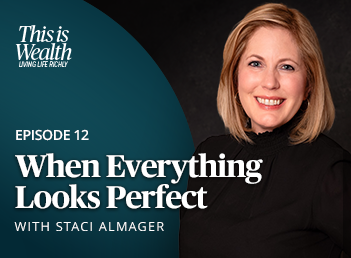Written By
Elizabeth Flavin Crawford, Partner | Chief Executive Officer
After nearly three decades of advising ultra-high-net-worth individuals, I’ve witnessed a truth that transcends balance sheets: retirement is about spending time doing the things you want to do. Yet for many successful executives and founders, discovering what that actually means can be surprisingly intimidating.
When Success Meets Silence
I recently worked with a client who had orchestrated a textbook business succession—his company thrived, the transition appeared seamless, and his financial future was secured. Six months later, he sat in my office, completely lost. “Everything I worked for feels like it’s been taken away,” he told me. Despite his sunset role and gradual transition, he hadn’t prepared for the emotional void that followed. He needed a therapist, not another investment strategy.
Another client retired after building his company for 35 years. Within weeks, he was following his wife around the house asking, “What are we doing today?” Her response was sobering: “I have my life, my friends, and my purpose. You need to find yours.”
Research confirms that retirement can trigger an existential crisis, particularly for those whose identities are deeply intertwined with their work. Harvard Business School professor Teresa Amabile’s research identifies this phenomenon as requiring both “life restructuring” and “identity bridging”—maintaining important aspects of yourself while building new structures for daily life.
The Identity Crisis No One Discusses
The psychological landscape of retirement involves multiple challenges including depression, anxiety, social isolation, and the loss of professional identity. For high achievers who’ve spent decades as needed decision-makers, the shock of “not being needed” can be profound. You don’t lose your work ethic or drive to make a difference when you retire—you lose the vehicle for that output.
Think about it: when someone asks what you do, you’ve had a ready answer for 40 years. Suddenly, that identity as a working person in a particular place, with certain people, doing specific things disappears, leading to feelings of sadness, grief, loneliness, and disorientation. These feelings are normal and expected, but they don’t need to linger.
The Sendero Guidance Process: Planning Purpose Alongside Portfolios
At Sendero, we’ve developed our Guidance Process to track the priorities and goals that matter most to our clients throughout life. When retirement approaches—ideally two years in advance—we shift focus to the emotional transition ahead. We don’t just discuss withdrawal rates; we explore what will get you out of bed each morning when the alarm no longer dictates your schedule.
Research from the Health and Retirement Study shows that successful retirement adjustment requires developing resources across multiple domains: financial, health, social life, and psychological planning. The journey typically involves five distinct stages: planning, honeymoon, disenchantment, reorientation, and stability. Understanding these phases helps normalize the emotional rollercoaster that many experience.
Finding Your Next Chapter
Contrast those struggling clients with another who strategically planned every aspect of his transition. He didn’t just arrange his succession and finances—he lined up volunteer work for causes he cared about, scheduled family trips for the next two years, and maintained his weekly golf games. The difference? He had already begun building his post-retirement identity before his last day at the office.
For executives and founders, I’ve seen particular success with these purposeful transitions:
- Sharing Your Expertise: Sitting on for-profit boards provides structured engagement and income while leveraging decades of experience. Mentoring entrepreneurs or serving as an executive coach offers the reward of giving back without the burden of daily management.
- Project-Based Consulting: Many retirees find that engaging in specific projects they want to accomplish provides the sense of purpose and achievement they miss from their careers. You choose the projects, set the timeline, and maintain control.
- Structured Volunteering: Rather than casual volunteering, consider leadership roles in nonprofits where your business acumen can drive real impact. One client transformed a struggling arts organization using the same strategies that built his fortune.
Practical Steps for Emotional Preparedness
Research suggests beginning to envision your retirement about five years before you expect to retire. Here’s what we recommend:
- Start the Conversation Early: Engage in open discussions with your spouse or partner about shared aspirations and how you’ll spend your time together—and apart. That client whose wife had her own life? They eventually found their rhythm, but it took honest conversations about boundaries and expectations.
- Test Drive Your Plans: Try out retirement activities before you leave work—join that board, start that volunteer project, take that extended trip. One client discovered his dream of daily golf lost its appeal after three weeks; better to learn that while still working.
- Maintain Social Architecture: Create a regular schedule filled with activities you enjoy—coffee with friends on Mondays, family dinners on Fridays. Structure doesn’t end with employment; it just becomes self-directed.
- Embrace Periods, Not Permanence: View activities as chapters in your life rather than permanent commitments—you can let go of old passions to make room for new ones without feeling like you’re giving up part of your identity.
The Promise of Purposeful Retirement
Recent research reveals something surprising: retirement can actually increase one’s sense of purpose in life, particularly for those who leave demanding or unsatisfying positions. The key is intentional transition planning that addresses identity, relationships, and daily structure—not just finances.
I tell my clients that retirement isn’t an ending—it’s finally having the freedom to spend time doing what you want to do. Most people haven’t had that option since childhood. Yes, it can be intimidating, but with the right preparation—emotional as well as financial—it can become the most fulfilling chapter of your life.
The clients who thrive in retirement aren’t necessarily those with the largest portfolios. They’re the ones who invested time in discovering their next purpose before they needed it. At Sendero, we believe planning for that purpose is just as important as planning your portfolio. After all, what good is financial security if you wake up each morning wondering what to do with it?
As CEO of Sendero, I’ve spent my career helping ultra-high-net-worth individuals navigate major life transitions. The insights shared here come from both extensive research and real-world experience guiding clients through the complex psychology of retirement.
Disclaimer: This article is for informational purposes only and does not constitute legal or tax advice. Please consult with appropriate legal and tax professionals regarding your specific situation.
Sources
https://pmc.ncbi.nlm.nih.gov/articles/PMC8985220
https://hbr.org/podcast/2019/01/how-retirement-changes-your-identity
https://www.frontiersin.org/journals/psychology/articles/10.3389/fpsyg.2017.01300/full


